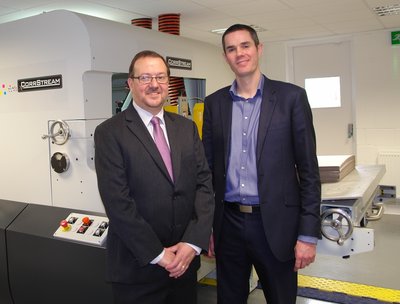Mark Eaton (left) and Sean Moloney with the CorrStream 20
*This article was first published in 2014, with the technology and pricing as reported correct at the time of publication; read here for up-to-date information on the market for digital corrugated printing, including on the Domino X630i
Inkjet direct to corrugated sheets has arrived in the shape of the Sun Automation CorrStream press range, which saw its worldwide launch in April. The first machine installations are planned for the end of the year. Sean Smyth went to see the new demo centre in Bristol.
Baltimore-based Sun Automation is a successful long established supplier into the corrugated sector. Its short edge feeder designed to handle sheets is widely used, and now it has launched a new series of high speed, single pass sheetfed colour inkjet printers for the corrugated market. The new demo centre in Bristol has just opened and houses the first model, the CorrStream 20.
Tech specs
There are three machines in the range, the CorrStream 20, 40 and 60. The print width varies, from 557 mm in the CorrStream 20, the CorrStream 40 is the same housing and transport (the 20 can be upgraded to a 40 in the field) with 783 mm maximum print width and CorrStream 66 with 1,345 mm. At launch, the press speed is 60 m/min and that will be upgraded to 75 m/min, the equivalent of some 4,200 sheets 1 metre in length per hour independent of the width.
The machine has a Sun Automation feeder onto a conveyor belt with holes that hold the sheets in position over a vacuum bed, which is critical for inkjet quality. The throw distance is some 3 mm, higher than for most webfed machines, to handle the variation in corrugated surfaces. The four colour print module applies water-based inks and moves from the rest and cleaning position over the board when running. Sheets then pass under an infrared drier into a stacker, where the stack is a little warm.
The print unit comprises four bars with inkjet heads mounted in an array, which according to global product manager for CorrStream, Sean Moloney, have been modified from the standard design (Sun is not disclosing the identity of the head or ink manufacturer).
The machine design maximises the reliability of the inkjet print module. The print bar always registers to the left edge of the sheet (as viewed from the feeder), so the image is always started from the same heads. The nozzles that are not used are kept open by intermittently ‘spitting’ drops onto the non-image area where they will not be noticed, and for narrow sheets, there is an ink collection area beside the moving belt
The print unit is moved onto a rest station when a job finishes, where the heads are parked and the cleaning cycle takes place. The machine in the demo centre has a glass-sided casing to allow the print operation to be viewed. The press features touch screen controls and an ErgoSoft RIP while Sun provides a front end workstation to set up jobs prior to operation; the power of the systems dependent on the press model and nature of the work.
Mr Moloney said the system will compete directly with flexo, increasingly important as changes in the market demand reductions in run lengths to reduce waste and inventory, in a similar way to the label sector.
New dimension
The company is currently developing new inks for coated stocks that will boost the quality, and could broaden the applications into cartons.
Mr Moloney commented, ‘This innovative technology, which incorporates new inks and print systems, is the culmination of several years of development work and it will bring a unique print dimension to the corrugated industry. Despite deploying some very sophisticated systems, we are confident CorrStream is an inkjet printer for mainstream production that users will find familiar.
‘Simple to operate, the three equipment option sizes provide high quality post print (HQPP) print quality at lower costs on the typical batch sizes now seen at many plants. It is only a matter of time for industrial inkjet to take hold in the graphics market on corrugated. This range of machines and their modular design will future-proof corrugated companies and help them to capitalise on new opportunities, with early adopters sure to benefit as the margins from other print processes come under increasing pressure.
‘Interest from marketers and packaging buyers in digital packaging is growing due to its ability to provide high quality, variable graphics with short lead times and lower stock costs. The corrugated industry needs to react and become yet more flexible in offering even greater variety in print to aid sales in an ever more sophisticated consumer space.’
These presses have been developed over many years. President of Sun Automation Group, Mark Eaton, suggested that a figure of $20 million was spent in bringing the system to market over a seven-year period.
The first machines will be placed in Europe rather than the USA because the market requirement for smaller lot sizes is much greater here. Mr Eaton claims that the technology will eventually replace flexo, although it may take 20 years. Time will tell if he is right, but that possibility is now closer with the launch of this machine.






